IJCRR - 10(17), September, 2018
Pages: 23-32
Date of Publication: 10-Sep-2018
Print Article
Download XML Download PDF
Review on a weed Parthenium hysterophorus (L.)
Author: Lalita, Ashok Kumar
Category: Life Sciences
Abstract:In the present time we are facing the infestation of Parthenium hysterophorus everywhere. It is available in stocks around the railway tracks, in bare lands, in agriculture fields, in orchards and forests, it invade major portion of Indian continental. We are familiar with Parthenium hysterophorus noxious properties and want to control its infestation. However, only controlling its growth is not a solution to remove it but it can be managed via its utilization for different purposes. Recently a lot of research has been going on to explore the utilization properties of Parthenium. This review article presents some properties and utility potential of Parthenium concluded by various researchers.
Keywords: Weed management, Allelopathy, Invasion, Herbicides
Full Text:
INTRODUCTION
Weeds in routine are known to be unwanted in a given situation and these are harmful, dangerous or economically detrimental having serious threat to primary production and biodiversity. Invasive Alien Species are known to be the species which are introduced from outside from its origin place to other countries either by deliberately or unintentional human activities. They have established self-reproducing populations in the wild and have caused evident changes in nearby, simulated as well as biological systems.. Invasion is known as very important hazard to biodiversity (2). They reduce farm and forest productivity. Parthenium hysterophorus is the main invasive alien weed which dominates over the native species and adversely affects the biodiversity. The word Parthenium is taken from the Latin word parthenice which means for medicinal uses (4)
Parthenium hysterophorus is an invasive weed plant of family Asteraceae. This erect, short-lived plant known for its flourishy growth and its abundance notably in hot climates. Parthenium is native plant of north-east Mexico and was endemic to America but now it is widely distributed in all countries of Asia and Europe. Parthenium (Parthenium hysterophorus L.) is known with different names in different countries such as carrot weed, star weed, congress grass, wild feverfew, ragweed, bitter weed, white top, and the “Scourge of India” .This weed with productive seed generation has high allelopathic impact on neighboring plants and competitiveness with economically important crops.
Spread of Parthenium hysterophorus has been documented to cause enormous loss to the biodiversity by replacing native species in the natural ecosystems, sometimes causing total habitat alteration. To know about Parthenium hysterophorus effects, habitat and its biology have immense significance in agriculture. Only with detailed knowledge of this noxious weed, it will be possible to controlled and manage the weed in different ways. Present review explores the possibility through knowing habitat, distribution, biology and chemical properties of Parthenium hysterophorus.
(1) Origin and Distribution of Parthenium
Parthenium hysterophorus is native to the region encompassing the Central America, Southern North America, Gulf of Mexico, West Indies, and Central South America. The weed has now spread all around the globe including mainland as well as island. In India and other countries of Asian continent such as China, Bangladesh, Nepal, Pakistan, etc, it has spread on alarming rate. Its spread and infestation are severe in some of the countries like Australia, South Africa, Ethiopia, India and Pakistan. It was introduced into Asia, Africa and Oceania with cereal and grass seed shipment from America during the 1950s (5).
(i) IN INDIA:
Parthenium hysterophorus possibly entered India in 1910 (with infected cereals germplasm) however, went unrecorded until 1956. The weed was first revealed in India in 1955 (38) and now happens everywhere the (48) in around 35 million hectares of land (23). In India, this weed has serious problem in approximate all states like Karnataka, Andhra Pradesh, Haryana, Bihar, and Madhya Pradesh and Uttar-pradesh (22). Parthenium hysterophorus occurred in all states of country and presenting a serious threat in many states those have large areas of agriculture land, non cropping areas and grazing land (25). At present time India has becomes one of the most infested countries of world.
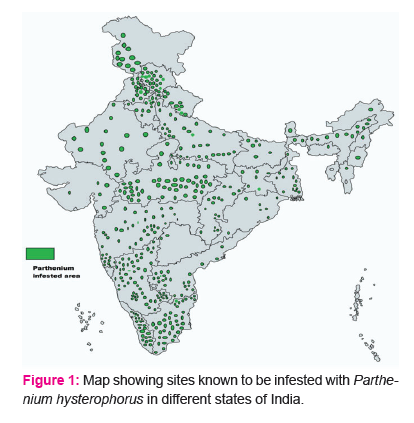
The spread of Parthenium hysterophorus has been reported from all states of India with different intensity. Generally, overall spread in terms of Parthenium density and dispersion level is maximum in Andhra Pradesh, Maharashtra, Bihar, Punjab, Chhattisgarh, Delhi, Haryana, Karnataka, Madhya Pradesh, Tamil Nadu and Uttar Pradesh; medium in Jharkhand, Assam, Gujarat, Rajasthan, Himachal Pradesh, Jammu & Kashmir, Uttarakhand, Orissa, and West Bengal; low in Andaman & Nicobar, Arunachal Pradesh, Goa, Kerala, Lakshadweep, Manipur, Mizoram, Meghalaya, Nagaland, Sikkim and Pondicherry. However its infestation varied in different states and different regions of states (Table 1)-
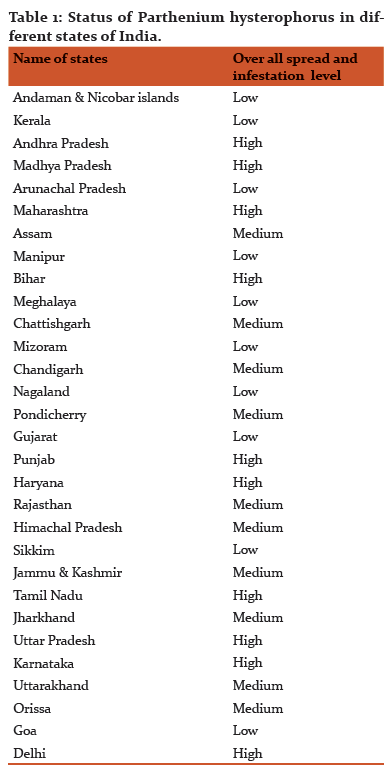
In U.P. earlier this weed was noticed at Pantnagar opposite to the railway station and has spread to a few agricultural lands and also in Rae-Bareily district and Jhansi areas (10). It grows most luxuriously in some districts especially 00around western U.P. Weed is found in plenty in the nearby agricultural lands, abandoned land and on the bank and the basin of rivers (29).
It is very well reported to occur in Western U.P. like Pilibhit, Puranpur Tehsil, Bisalpur Tehsil, Shahjahanpur, Mala and Deoria forest (Pilibhit) Badaun, Bareilly, Etah, Aligarh, Hathras, Firozabad, Mainpuri, Mathura, Moradabad, Meerut, Bijnor, Rampur, Jyotiba-Phule Nagar, Baghpat, Muzaffarnagar, Saharanpur, and other parts of the state (32).
There are less data available on the abundance of Parthenium hysterophorus in Meerut district due to less research, but there are plenty of Parthenium found grown in the bare areas, railway platforms and in agriculture lands.
(2) HABITAT: This exotic weed is generally spotted on bare lands, industrial areas, developing residential colonies, railway tracks, roads, drainage and around the ditch etc. This weed also grows vigorously in gardens, forests and agricultural fields. Due to its high luxuriance growth, it can produce about 15,000 seeds/ plant, which can disperse and germinate to different area in a large amount. It has potentiality to adjust to a variety of habitat conditions. It infest woodland, open spaces of urban regions, overgrazed pastures, developed terrains, irritated and uncovered zones, for example, roadsides, tracks, and intensely loaded regions, for example, stockyards and watering areas such as irrigation canal, water channels and ditch(43). It grows better in hot climates. High temperature is favorable for the development of this noxious weed production. Low temperature represses the development of the plant and the seed productivity (33). Under favorable climatic conditions like more than 500 mm average rainfall and 30°C mean temperature Parthenium hysterophorus can reach heights of 1.5 to 2.0 m. Under dry conditions, the plants may mature and set seed at even heights of only 10 cm.
This weed is characterized by its density and biomass varying with soil type. It prefers alkaline clay, loam soil to heavy black clay soils to grow luxuriously (3). Parthenium invaded sites mostly have sandy loam soil with pH ranging from 5.4 to 7.4, water holding capacity 16.8 to 63%, total nitrogen 0.055 to 0.206%, organic matter 1.134 to 4.24%, phosphorus 31.86 to 69.93 kg/ha, potassium 74.72 to 746.5 kg/ha(15). Parthenium has ability to can grow over a wide range of moisture, pH and temperature conditions however it requires high soil moisture for its seed germination. Reportedly it is a photoperiod and thermo-period insensitive and can flower year-round. Seed germination can happen over an extensive range of temperature and soil pH. Further, it is very competitive to compete with a number of crops including legumes & cereals.
(3) INFESTATION OF PARTHENIUM HYSTEROPHORUS
(a) Agriculture and pastures ecosystems:
Before 1980 this weed was seldom noticed growing in crop lands but now it has spread too much extent into almost all types of agriculture crops, forests and plantation ecosystems. In Uttar-pradesh, Uttarakhand, Andhra Pradesh, Karnataka, Madhya Pradesh, Maharashtra, etc., Parthenium is known as harmful weed of agriculture lands. In crop fields, where only one crop is grown in a year, it grows abundantly in the fallow period following the occurrence of mild rains. Its infestation is severe in the field where irrigation canals are used. On the bank of narrow, human-made waterway systems(water canal or ditch), Parthenium hysterophorus weed grows abundantly due to the good availability of moisture and its seeds being carried by irrigation water canal.
(b) Orchards and forests ecosystems:
Earlier, it was not known for its infestation in gardens and forests but at present time it spread vigorously into these areas. This weed grows luxuriantly in orchards because of low weeding practices in such ecosystems. Mango orchards in Uttar Pradesh, Madhya Pradesh and Mahrashtra are frequently invaded by Parthenium weed causing a nuisance to growers. In Himachal Pradesh, this weed has spread in the majority of apple orchards grown in the lower elevations. Similarly in Maharashtra, orange orchards have been invaded with Parthenium weed causing problems to growers. Parthenium can grow luxriously in bare lands/wastelands and in forests, it inhibits the growth of other plants by which local bio-diversity being threatened. Parthenium weed has invaded numerous National Parks of India including Pench, Rajaji, Kanha, Bandhavgarh etc. (25).
(c) Bare lands
Parthenium hysterophorus vigorously grows in bare lands. It can be seen growing everywhere either on roadside, around the factories or mills, platforms and even the lands which are not suitable for crop production due to their high metal toxicity or scarcity of the mineral nutrients. It is the important feature of Parthenium weed that it has a wide range of habitat and it can be survive in harsh conditions in which other normal plants cannot survive. It is an important reason of the rapid infestation of Parthenium in India and other countries as alien weed.
(4) MORPHOLOGY
Parthenium hysterophorus is highly branched, short lived (annual), upright (erect) herbaceous plant that form a rosette habitat during the early stage of life. At maturity, but occasionally can reach up to 2m or even more in height.
STEM
Stem is cylindrical, solid, more or less fluted with longitudinal lines corresponding to the extension of the midrib of the leaves. Mature stems are greenish and covered with small soft hairs which are known as hirustle, stems become much harder as reach to maturity.
LEAVES
The leaves are alternately arranged and stalked (petioles) upto 2 cm long founds in two different forms. During the early stages of life it forms rosette habitat. Leaves are alternate, simple and deeply pinnatifid. The blade is 11 to 15 cm long and 6-10 cm wide, the blade of lower leaves are broad and intensely divided in comparison to upper leaves. Abaxial surface of leaves are covered with short, stiff hairs that lie close to the surface.
FLOWERS
Numerous small flower- heads generally known as capitulum are organized in clusters at the top of the branches (in terminal panicles). Each flower-head (capitulum) is borne on a stalk (pedicel). Capitulum (3-5 mm across) are off-white or white in color containing ray florets (0.3-1 mm long). They also have various (15-60) small flowers (tubular florets) in the centre surrounded by two rows of small green bracts (an involucre). It can flowered at any time of the year, but commonly occur during raining season.
SEED
Five small ‘seeds’ generally known as achenes are produced in each flower-head . Seeds are black obovoid, 2 mm long and 1.5 mm wide consisting two or three small scales known as pappus about 0.5-1 mm in height, two straw-colored papery structures (actually dead tubular florets), and a flat bract.
(E) Seed biology, germination and longetivity
After 24-48 days of germination flowering takes place in Parthenium. This can happen at any time of the year. The best alternating temperature regime for its weed seed germination is 21/16 ?C (day/night). Further its seeds can live for between 4-6 years in the soil as seed bank. Studies have also shown their buried seeds to live much longer than seeds on the soil surface (1).
(5) HOW IT IS SPREADS
Parthenium hysterophorus retain an extraordinary capability to spread grow and established well in wide range of environmental conditions (Monika, 2014). It completes life -cycle 90-120 days which helps in quick spreading (20). Its seeds can be dispersed through various methods such as water current, animals, movement of vehicles, machinery, livestock and the grains or seeds of crops. Further Parthenium has a relatively short life cycle, grows very quickly and survives under different habitats. Generally for long distances it spread through vehicle, agricultural instruments and with water flow. Parthenium produced enormous number of tiny seeds which are light weight and can survive as seed bank in soil for long time (7). These some abilities of Parthenium hysterophorus helps to spread rapidly resulted in infestation of Parthenium everywhere.
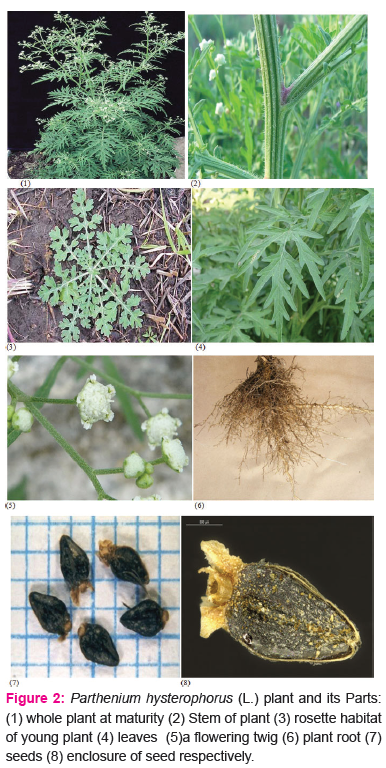
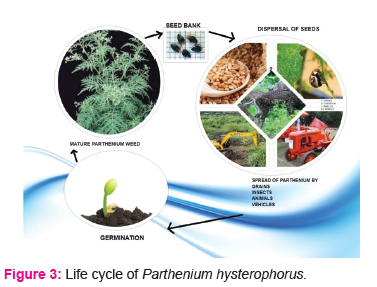
(5) Causes of rapid spread
-
High reproductive potential:
Parthenium hysterophorus produce a huge quantity of seeds with up to 15-25,000 seeds per plant (30) with an tremendous seed bank, estimated about 2,00,000 seeds/m2 in bare lands and agriculture field (15). Seeds of Parthenium can survive under harsh conditions and remain viable for a long time period. These qualities of this weed help in its fast spreading. Seeds of Parthenium can germinate any time of the year, when suitable moisture is available (46).
-
Fast growth rate:
It is vigorously growing annual herbaceous weed. Generally, Parthenium flowered when it is only 4-8 week old and can flower for several months. Under unfavorable conditions like salt and drought stress, the weed can completes its life cycle within 4-5 weeks.
-
Allelopathic potential:
This noxious weed suppress the development of nearby plants by allelopathy. Leachate and extract of leaves and inflorescence prevent the germination and growth of associated economically important crops. Kumari et al. (2014) observed that physiological and biochemical parameters remarkably reduced when aquous extract of Parthenium were directly sprayed on the crop plants. Parthenium has strong allelopathic effects on other plants even it can cause 40-80% yield loss in agricultural crops.
-
Unpalatable to animals:
Parthenium hysterophorus is unpalatable to the animals. Generally animals do not eat Parthenium hysterophorus because of its bitter taste and intense odour (14). Earlier investigations in India had revealed its serious health hazards to the livestock in Parthenium hysterophorus invaded areas. Being unpalatable,it can not use as animal fodder and its population is increasing day by day unless mechanically removed.
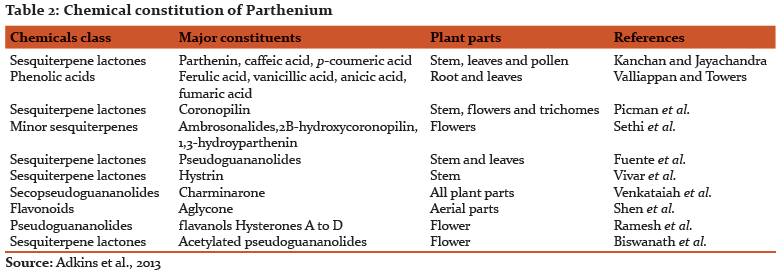
(7) IMPACT OF PARTHENIUM
-
Impact on Biodiversity
This weed has the potential to disturb the natural ecosystem, as it can grow throughout the year in almost all drastic conditions suppressing native vegetation. Owing the absence of effective natural enemies, its allelopathic effect as well as photo insensitivity and thermo insensitivity, it is a threat for natural diversity. Rapid spread of Parthenium can disturb natural ecosystem because it has very fast infestation capacity and allelopathic potential which have the ability to disrupt any type of natural ecosystem. Species richness, evenness an local biodiversity gradually decrease where this plant is present, this situation clearly indicates the native biodiversity loss of weeds and other crop plants due to Parthenium infestation. Its infestation is coupled with its allelopathic potential and the absence of its natural inhibitors such as pathogen, insects and their larvae, these are the some important factor which are the reason of its luxurious growth and spread (22). The concentrations of allelochemicals viz. Coronopilin, caffeic acid, parthenin, and p-coumaric acid which are present in Parthenium have serious allelopathic effects.
-
Impact on Crop production
The Parthenium hysterophorus weed has infested in a large area of india (24). This plant contains parthenin, hysterin, hymenin, and ambrosin. Due to the presesnce of these allelochemicals this weed has strong allelopathic impacts on different crops and human being also (11). This weed have adverse impacts on legumes by disturbing their symbiosis with Nitrogen fixing bacteria such as Rhizobium, Azotobacter, Azospirillum and Actinomycetes. It produces huge numbers of pollens ( Approx. 700 million), which travels a long distance from source plant to other crop plants and inhibits the fruit setting in these crop plants such as tomato, brinjal, beans, and ceraels. Parthenium can cause yield loss upto 40% in legume crops (19).
-
Impact on Soil Microflora
Parthenium is known to its inhibitory effect on growth and activity potential of different bacterial species related to Nitrogen assimilation such as Rhizobium and Azotobacter and nitrifying bacteria like Nitrosomonas. Aqueous extract of Parthenium has detrimental effects on the growth of Rhizobium, Nitrosomonas and Azotobacter. It reduced the Legheamoglobin content of root nodules by which Rhizobium-legume symbiosis is affected. Leaf and root leachates and their chemical component inhibit nitrate production (45). Besides these it can inhibit the growth of algae and mycorhyzzae associated to crop plants because of its fungicidal property (Megharaj et al., 1987).
-
Effects on Animals
Parthenium weed is noxious for livestock, it can cause dermatitis and skin disorders in animals (12). loss of skin pigmentation, dermatitis, mouth ulcers with extreme salivation and diarrhoea has been observed in animals. If excess amount of this weed is eaten by the animals it can cause death. The Parthenium extract reduce the total WBC count in animals wich results in the weaknig of immune system.
-
Effects on Human Beings
Parthenium plant parts can be toxic to some people it is estimated up to 73% of people living with the weed are sensitive to it. Females are twice more likely to be sensitive than males. Dermatitis, hay fever, asthma, and bronchitis are the major health problems found in human beings caused by the pollen grains and other plant parts of Parthenium. The major allergens found in this plant are parthenin, coronopilin, tetraneuris, and ambrosin. Its pollen grains are well known to causing asthma in human beings. Direct contact of this plant can cause dermatitis not only site specific but can spread all over the body. Clinically the Parthenium dermatitis can be divided into five types which are-
-
The classical pattern
-
The chronic actinic dermatitis (CAD)
-
The mixed pattern (classical and chronic actinic dermatitis pattern combination)
-
The photosensitive lichenoid eruption
-
The prurigo nodularis like pattern (4).
(8) CONTROL OF PARTHENIUM
The control of Parthenium weed is a serious challenge due to its vigorously spreading nature. Immediate actions are being quite necessary to eradicate the plant since it has more hazardous impact on environment as well as to public health. India has great risk of rapid invasion of the weed in agricultural lands, for which it might gave proper attention towards the remedy to control Parthenium. Many researches are going on for finding the cheap and best way for its control. Some of the control measures that can be undertaken in India are as follows-
- GRASSLAND MANAGEMENT
Grazing management is the most useful method for the control and manage the Parthenium spread on a large scale. However, this practice has not been implemented effectively in India. Meadow land can be sustain with growing grasses and herbs in them. This may however, requires rehabilitation of poor meadow followed by sound grazing maintenance programs. Such a practice, however, has a lot of challenges in our country due to socioeconomic and cultural factors.
- CONTROLLING OVERGRAZING
Overgrazing may increase the Parthenium hysterophorus infestation. Control of overgrazing therefore can minimize its infestation to some extent. Overgrazing due to the explosive increase in livestocks populations decreases the vigor and diversity of grassland that enable the spread of Parthenium hysterophorus weed luxriously. So maintenance of correct stock number might be fruitful in the control of Parthenium weed dispersal(31). Alternatively, pasture spreading can be helpful for rehabilitation of pasture lands which might be more effective than simply reducing the weed. However, overgrazing must be avoided Spring-summer period is found to be quite suitable for pasture sapling with first 6-8 weeks being quite important. Grazing during winter is generally safe since the period has low risk of Parthenium spread. However, Parthenium may grow and germinate in this time also.
- BURNING
Another commonly practiced way of controlling Parthenium hysterophorus weed is burning. Mass vegetation of the weed can be destroyed by this practice. But it can not be considered as safe control strategy for the weed since there is great risk to soil, air and existing plant and animal diversity. Parthenium hysterophorus ash also has allelopathic effect on crop yield but yield loss is low in comparison to the leachate and dry mass of this weed (22).
- MANUAL CONTROL
Manually, Parthenium weed can be controlled by simple hand plucking. But this is not recommended since it might cause serious health hazard. Further, the seeds may drop off and increase the area of infestation.
- HERBICIDE CONTROL/CHEMICAL MANAGEMENT
Chemical management or herbicidal control is the most widely used to control the growth of Parthenium hysterophorus However, now we focuses on bioherbicides but it is not effective as chemical herbicides till now. Chemical herbicides which are commonly used are glyphosate @ 2.5 kg /ha-1, atrazine @ 2.6 kg/ ha-1, bromoxynil @ 0.56 kg/ ha-1, common salt @ 20%, 2,4-D amine @ 3 l/ ha-1, 2,4-D ester @ 4 l/ ha-1, Floumeturon @ 2.24 kg/ ha-1, Hexazinone @ 3.5 kg/ ha-1, Metribuzin @ 0.7 kg/ha-1, Norflurazon @ 2.24 kg /ha-1 and Paraquat 0.5 l/ ha-1. These herbicides are well known for their ability to control this weed. (16, 39,41,27).
The stage and time of the rosette stage is the right time to apply post emergent herbicides in wasteland, non-cropped areas, along railway tracks, water canals and roadsides (Khan et al., 2012). Very effective treatments for P. hysterophorus control were noticed glyphosate and metribuzin, having higher effect at 28 after the herbicide application. Applications of herbicides further divided into two branches which are as follows-
- Non-cropping areas
Parthenium should be eradicated by herbicide treatment early before it can set seed. Small and isolated areas of infestations can be treated immediately. Repeated spraying is necessary to prevent seed production. Spraying should be done before the flowering when the plants are small. Active growth of other grasses could be prompted for simultaneous control of the weed. Some of registered herbicides to control Parthenium weed are: atrazine, 2, 4-D+picloram (trodon 75-D) 2,4-D ester, glyphosate, metasulfuron methyl (for seedlings only), hexazinone, dicomba, etc (CRC 2003). These herbicides in different concentrations are effective for spot spray or boom spray or both.
- Cropping areas
Chemical herbicides can be used in non-cropping area without any problem but it is little bit risky to practicise these herbicides in cropping areas because these can harm crop plants. So use of chemical fertilizers in agriculture land requires precautions to choose the herbicides so that it can not harm crop plants. The biological or natural herbicides, like the volatile oils from aromatic plants in very low concentration are quite helpful on such areas to abort Parthenium seeds (42). These essential oils have no or little effect on the existing vegetation/crops (13). Observations have revealed that essential oils from different plants such as Eucalyptus sp., Ageratum, Lantana camara etc. can be used for the control of Parthenium.
- BIOLOGICAL CONTROL
Biological control might be one of the best methods for controlling the Parthenium weed dispersal. It can be done by the use of insects which can feed on Parthenium hysterophorus and we can also used fungi, bacteria and plants which have adverse effects on Parthenium. The moth Epiblema strenuana (introduced form Mexico) has been established in all Parthenium dominated areas. The moth’s larvae feed on the stem of the weed and forms ball which inhibit the plant growth. Some other released insects which are found to be beneficial in controlling the weed.
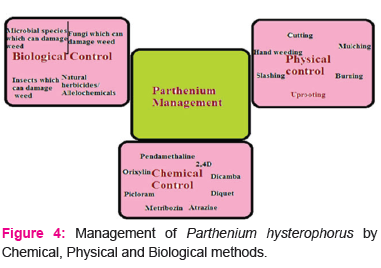
- CONTROL BY OVER USE OF THE WEED
This weed can be managed by enhancing its utility for different purposes. It can be extensively used for biogas production, as green manure and flea-repellant and herbicide. Over-exploitation of Parthenium for its beneficial use thus should be prompted in the developing countries like India where implementation of other alternative and expensive control measures is difficult.
(9) UTILIZATION OF PARTHENIUM
- Use as a Traditional Medicinal plant
Parthenium hysterophorus accidently entered India in 1910 with the germplasm of cereal grains, and is now considered as an obnoxious weed in our country (37). The noxious impacts of Parthenium have been well documented not for human health but also for livestock and native plant species. It causes serious effects like asthma, bronchits, dermatitis (allergic reaction), and hay fever in human being. Despite this problem it has also been used in industry for its noxious, insecticidal, nematicidal and herbicidal properties as well as for composting (Sastri and Kavathekar 1990). The bisque of root used as remedy for amoebic dysentery. The sub-lethal doses of parthenin extract help in reducing cancerous activity in the cells of mice. Investigations also revealed that Parthenium can be used to cure the hepatic amoebiasis, neuralgia and certain types of rheumatism (40). In America, it is applied externally on skin as remedy for a wide variety of diseases. In Jamaica, the elixation is used to kill the flea in animals (8).
- Antifungal:
As mentioned earlier Parthenium have antifungal effects on different fungal species. This quality of Parthenium can be used to cure the human and animal fungal diseases. Antifungal potential of different extracts of Parthenium hysterophorus against human pathogenic fungi were investigated by Rai (36) and Rai (35). Fungi related to dermititis found sensitive to sequestoterpene lactone found in Parthenium hysterophorus and it can used for the remedy of skin diseases (37).
- Antioxidant:
Parthenium hysterophorus methanolic extracts showed high antioxidant effect. Therefore, it can be utilized as natural antioxidants. It is naturally available antioxidant, if it will be commercially available it can replace synthetic antioxidant which have harmful impacts on human health (18). It is more valuable to produce antioxidant naturally after the research that synthetic antioxidants have high carcinogenicity in comparison to naturally produced antioxidant.
- Antitumor:
Parthenium hysterophorus’s
References:
-
Adkins, S and Shabbir, A., 2014. Biology, ecology and management of the invasive parthenium weed (Parthenium hysterophorus L.). Pest Manag. Sci.; 70(7): 1023-1029.
-
Akter A and Zuberi, MI., 2009. Invasive alien species in Northern Bangladesh: Identification, Inventory and Impacts. Intl. J. Biodivers Conserv; 1(5): 129-134.
-
Annapurna, C, and Singh, J S.,2003. Variation of Parthenium hysterophorus in Response to Soil Quality: Implications for Invasiveness. Weed Research; 43 (3): 190–198.
-
Bailey LH.,1960. Manual of cultivated plants, Macmillan, NewYork.
-
Bhowmik, PC and Sarkar, D., 2005. Parthenium hysterophorus L.: Its World Status and Potential Management. International Conference on Parthenium Management, Bangalore; 1-6.
-
Datta, S and Saxena, DB.,2001. Pesticidal properties of parthenin (from Parthenium hysterophorus) and related compounds. Pest Manage. Sci; 57: 95-101.
-
Dogra et al.,2011. Distribution, Biology and Ecology of Parthenium hysterophorus L. (Congress Grass) an invasive species in the North-Western Indian Himalaya (Himachal Pradesh). African Journal of Plant Science; 5(11): 682-687.
-
Dominguez, XA and Sierra, A.,1970. Isolation of a new diterpene Alchohol and parthenin from Parthenium hysterophorus. Planta Medica; 18:275-277.
-
Dwivedi et al., 2009. Parthenium sp. as a plant biomass for the production of alkali tolerant xylanase from mutant Penicillium oxalicum SAU- 3.510 in submerged fermentation. Biomass Energy; 33:581-588.
-
Ellis, JL, Swaminathan, MS.,1969. Notes on some interesting plants from south India. Journal of the Bombay Natural History Society; 66: 233-234.
-
Gunaseelan, V N., 1987. Parthenium as an additive with cattle manure in biogas production. Biol. Wastes;21: 195–202.
-
Gunaseelan, VN., 1998. Impact of anaerobic digestion of inhibition potential of Parthenium soils. Biomass Bioenergy; 14:179–184.
-
Isman, MB.,2000. Plant essential oils for pest and disease management. Crop Protection; 19:603- 608.
-
Javaid, A and Anjum, T, 2005. Parthenium hysterophorus L. — a noxious alien weed. Pakistan Journal of Weed Science Research;11:1–6.
-
Joshi, S.,1991. Biological control of Parthenium hysterophorus L. (Asteraceae) by Cassia uni?ora Mill (Leguminosae) in Bangalore, India. Tropical Pest Management; 37: 182-186.
-
Kathiresan et al.,2005. Ecology and control of Parthenium invasion in command area. Conference on Parthenium Management. Bangalore, India: 77-80.
-
Khaket et al., 2015. Parthenium hysterophorus in current scenario: A toxic weed with industrial, agricultural and medicinal applications. J. Plant Sci; (10): 42-53.
-
Khan et al., 2011 Nutritional investigation and biological activities of Parthenium hysterophorus. Af. J. Pharm. & Pharmacol; 5 (18): 2073-2078.
-
Khosla, S N and Sobti, S N.,1981, Effective control of Parthenium hysterophorus L. Pesticides;15:18-19.
-
Kohli et al., 2006. Status, invasiveness and environmental threats of three tropical American invasive weeds (Parthenium hysterophorus L., Ageratum conyzoides L., Lantana camara L.) in India. Biological Invasions; 8:1501– 1510.
-
Kumar et al., 2011. Impact of Parthenium hysterophorus leaf extracts on the fecundity, fertility and behavioral response of Aedes aegypti L. Parasitol. Res; 108: 853-859.
-
Kumar, S. 2014. Spread, maintenance and management of Parthenium. Indian Journal of Weed Science; 46(3):205–219.
-
Kumar, S. and Varshney J G., 2007. Biological control of Parthenium : present and future, National Research Centre for Weed Science, Jabalpur, India; pp-157.
-
Kumar,S 2009. Biological control of Parthenium in India: status and prospects. Indian Journal of Weed Science ;41(1&2) : 1-18.
-
Kumar,S., 2012. Current spread, impact and management of Parthenium weed in India. International Parthenium News;5: 1-6.
-
Kumari et al., 2014. Impact of Parthenium hysterophorus L. invasion on species diversity of cultivated fields of Bilaspur (C.G.) India. Agricultural Sciences; 5: 754-764.
-
Mishra, JS and Bhan, VM., 1994. Efficacy of sulfonyl urea herbicides against Parthenium hysterophorus. Weed News; 1: 16.
-
Mukherjee, B and Chatterjee, M., 1993. Antitumour activity of Parthenium hysterophorus and its effect in the modulation of biotransforming enzymes in transplanted murine leukaemia. Planta Medica; 59(6): 513-516.
-
Murthy et al., 1977. Parthenium, a new pernicious weed in India. University of Agricultural Sciences, Technical Series;17: pp- 66.
-
Navie S, 2003. The biology of Parthenium hysterophorus L. in Australia. PhD Thesis, The University of Queensland, Brisbane, Australia.
-
Nigatu et al., 2010. Impact of Parthenium hysterophorus on grazing land communities in North-Eastern Ethiopia. Weed Biol. Manage;10: 143-152.
-
Prakash et al., 2017. Medicinal Plant Resources of Western Uttar Pradesh State of India. IOSR Journal of Environmental Science, Toxicology and Food Technology; 11( I): 01-12.
-
Pandey et al., 2003. Growth, reproduction, and photosynthesis of ragweed parthenium (Parthenium hysterophorus). Weed Sci.; 51:191–201.
-
Patel, S., 2011. Harmful and beneficial aspects of parthenium hysterophorus: an update. Biotech;(1): 1-9.
-
Rai MK., 1995. Comparative antimycotic activity of different parts of Parthenium hysterophorus L. World Weeds; 2 : 53-57.
-
Rai MK and Upadhyay SK., 1990. In vitro efficacy of different extract of Parthenium hysterophorus Linn. Against human pathogenic fungi using different techniques. Indian J. Pathol. And Microbiol.; 33(2): 179-181.
-
Rai et al., 2003. Plant derived antimycotics: Potential of Asteraceous plants. In Plant derived antimycotics: Current Trends and Future prospects : Howorth Press, N-York, London, Oxford: pp. 165-185.
-
Rao, R S., 1956. Parthenium, a new record for India. Journal of Bombay Natural History Society; 54 : 218-220.
-
Reddy, K N and Bryson, CT., 2005. Why ragweed parthenium is not a pernicious weed in the continental USA. Conference on Parthenium Management. Bangalore, India: 61–64.
-
Sharma GL and Bhutani KK., 1988. Plant based Antiamoebic drugs part ii :Amoebicidal activity of parthenin isolated from Parthenium hysterophorus. Planta Medical; 54(2):120-122.
-
Singh et al., 2003.Assessment of allelopathic properties of Parthenium hysterophorus residues. Agric Ecosys Environ; 9:537–541.
-
Singh et al., 2005. Herbicidal activity of volatile oils from Eucalyptus citriodora against Parthenium hysterophorus L. Annal. App. Biol.;146: 89-94.
-
Singh et al., 2004. Control of Ragweed Parthenium (Parthenium hysterophorus) and Associated Weeds. Weed Technology ;18 (3): 658–664.
-
Sohal et al., 2002. Evaluation of the pesticidal potential of the congress grass, Parthenium hysterophorus Linn. on the mustard aphid, Lipaphis erysimi (Kalt.). J. Environ. Biol; 23: 15-18.
-
Sukhada, KD and Jaychandra 1981. Effect of Parthenium hysterophorus on nitrogen fixing and nitrifying bacteria. Canad. Journ of Bot.; 59: 199-202.
-
Williams, JD, and Groves, RH., 1980. The Influence of Temperature and Photoperiod on Growth and Development of Parthenium hysterophorus.Weed Research ;20 (1): 47–52.
-
Yadav, A and Garg, VK., 2011. Recycling of organic wastes by employing Eisenia fetida. Bioresour. Technol; 102: 2874-2880.
-
Yaduraju et al., 2005. Parthenium hysterophorus L. distribution, problems and management strategy in India. International Conference on Parthenium Management Bangalore, India; 6-10.
|






 This work is licensed under a Creative Commons Attribution-NonCommercial 4.0 International License
This work is licensed under a Creative Commons Attribution-NonCommercial 4.0 International License